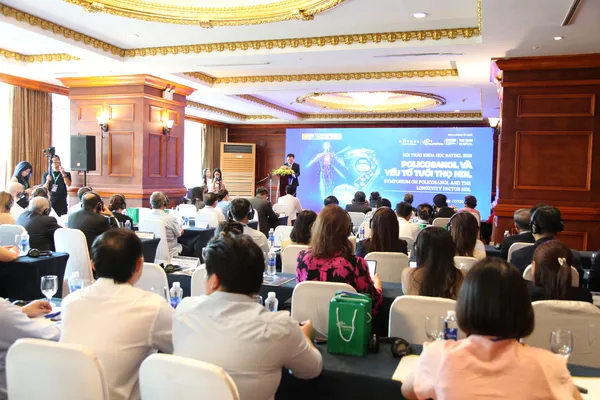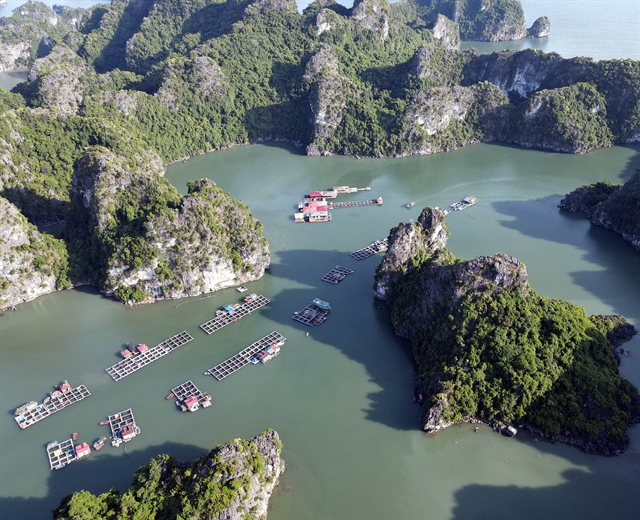 Life & Style
Life & Style

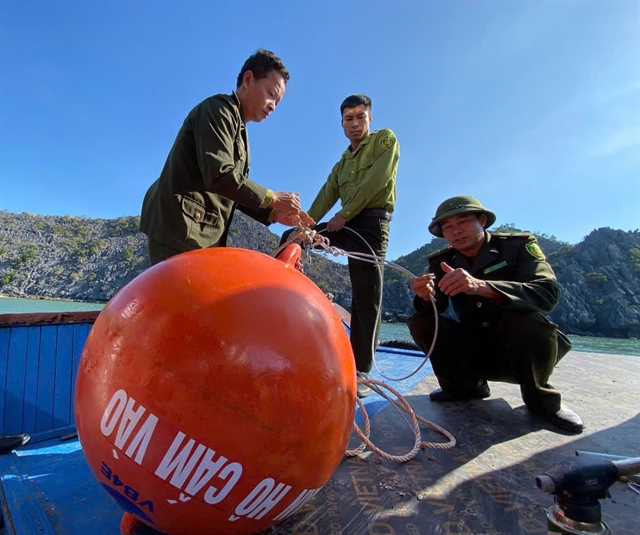 |
| Staff at the Cát Bà National Park in Hải Phòng City prepare to release a mooring buoy into the sea in an attempt to better manage and protect coral reefs at Cát Bà Archipelago. Photos courtesy of the International Union for Conservation of Nature (IUCN) |
Khánh Linh
HẢI PHÒNG – Most coral reef conservation areas in Cát Bà Archipelago, located within the Cát Bà National Park in Hải Phòng City, lack an adequate mooring buoy system.
Activities such as fishing, aquaculture and tourism services directly affect the coral reefs, leading to significant ecosystem degradation. Experts emphasise the urgent need for a comprehensive buoy system.
Nguyễn Văn Thịu, Director of Cát Bà National Park, said that the park was established on March 31, 1986, covering approximately 17,362 hectares, including 10,912 hectares of islands and 6,450 hectares of sea.
The national park holds significant value for its natural landscapes, biodiversity and diverse ecosystems. It serves as the core area of the Cát Bà Archipelago World Biosphere Reserve and the core zone of the Hạ Long Bay - Cát Bà Archipelago World Natural Heritage Site.
The Cát Bà Archipelago, in particular, serves as a breeding ground for marine life in northern Việt Nam, and its coral reef ecosystems play a crucial role for humans and the marine environment.
Coral reefs not only provide habitats for diverse marine species but also offer organic materials, shelter and nurseries for aquatic organisms, forming a vital ecosystem that sustains and regenerates marine resources. However, economic development, unregulated tourism activities, and rampant, unplanned aquaculture have placed enormous pressure on the environment and coral ecosystems in the region, he said.
“Overexploitation and destructive practices such as using explosives and electric fishing methods have significantly reduced natural resources," Thịu said.
"These factors have caused a continuous decline in coral reefs over the past 15 years in coverage, area and species diversity. Additionally, natural environmental factors and slow recovery rates have further diminished their distribution,”
The first buoys
To better manage and protect coral reefs at Cát Bà National Park, the Vietnam Business for the Environment (VB4E) Alliance, the International Union for Conservation of Nature (IUCN), and Cát Bà National Park initiated a coral reef monitoring programme between 2021 and 2022. The programme aimed to propose effective management strategies for coral reef conservation.
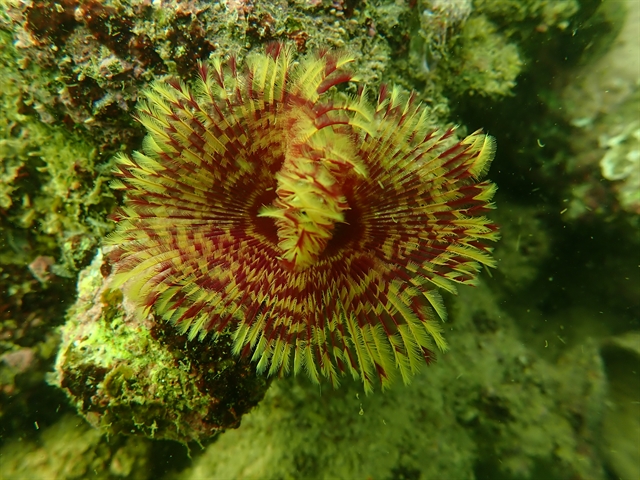 |
| A sample of coral reef at the Cát Bà Archipelago. |
Over two years, monitoring was conducted in three areas of Vạn Tà, Ba Đình and Giỏ Cùng. The monitoring revealed that coral reef health in Cát Bà was moderate, with slow coral growth and low species diversity. Indicator species, especially fish, showed low densities, and sporadic coral bleaching was observed in some areas.
Based on these findings, the national park proposed measures to enhance coral reef conservation, including installing mooring buoys in key areas.
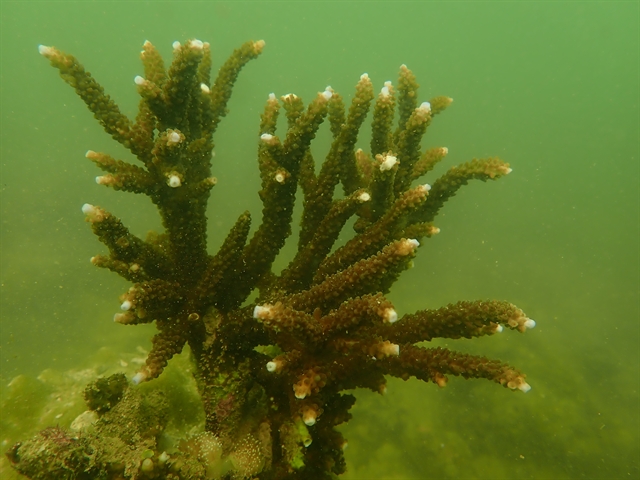 |
| The coral reefs in Cát Bà show slow growth in coral coverage and low species diversity. |
In 2023-2024, IUCN, through VB4E, supported Cát Bà in deploying buoys in areas with healthy coral reefs that require protection, such as Vạn Tà, Ba Đình and Giỏ Cùng. Over two years, 23 buoys were deployed, covering nearly 34 hectares of coral reef areas.
The buoys, imported and made from composite materials, cost approximately VNĐ10 million (US$394) each, including floating components, chains and anchoring systems. These buoys clearly demarcate coral reef areas, helping fishing and tourism boats steer clear and aiding patrol and enforcement efforts.
This initiative marks a significant step towards preserving the invaluable coral reef ecosystems of Cát Bà National Park.
“The deployment of buoys is of immense importance,” said Thịu,
“The buoys effectively raise awareness among fishermen, boat operators, and tourists about coral reef areas, encouraging them to avoid these zones.
"They also aid park staff and rangers by facilitating more focused and frequent patrols in these areas, enabling the detection and handling of violations. This effort helps enhance community awareness, encouraging locals to work alongside authorities in protecting and conserving marine ecosystems and coral reefs.”
To ensure the buoys are effective, Cát Bà National Park staff have conducted extensive research and consulted with marine scientists. This approach aims to address challenges posed by the marine environment, such as saltwater corrosion and biofouling by organisms like oysters and barnacles, which can weaken buoy ropes or puncture the floats.
The buoy system requires maintenance at least once a year, according to Thịu.
Storms and tropical depressions present significant challenges to maintaining the buoy system. During Typhoon Yagi in September 2024, the national park lost all 40 buoys deployed since 2013 as part of the ecological zoning system. Additionally, five of the 12 buoys released in 2023 were also lost.
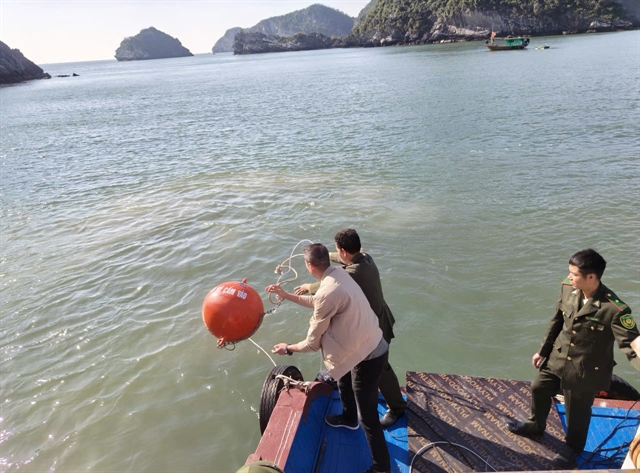 |
| A representative of TH Group and staff of Cát Bà National Park release a mooring buoy at the Cát Bà Archipelago on Friday. VNS Photo Khánh Linh |
In a collaborative effort to protect coral reefs and preserve the marine environment, the Food Chain Joint Stock Company (THFC), a member of TH Group, donated five buoys and accompanying equipment to the national park on Friday.
“Through our partnership with VB4E, the company has come to understand the financial challenges faced by conservation organisations,” said Nguyễn Thế Phương, a representative of TH Group.
“This is why private sector involvement, like ours, is crucial to inspire and encourage other businesses to join the mission of conserving the nation’s rich biodiversity resources.”
More buoys needed
Following Typhoon Yagi, the park staff reinforced the buoy system, repairing chains and float components to prevent parasitic organisms from causing further damage.
Thịu acknowledged that the current number of buoys is insufficient to cover the coral reef areas needing protection. However, he emphasised their value as an educational and awareness-raising tool for the community, fostering recognition of the importance of coral reef conservation.
In addition to deploying buoys, the park is intensifying patrols, inspections and legal education efforts targeting both tourists and local residents. These combined measures aim to build a collective effort toward the protection and preservation of coral reef ecosystems, he added.
Nguyễn Đăng Ngải, Deputy Director of the Institute of Marine Environment and Resources, highlighted that one of the most effective strategies for coral reef conservation is zoning for protection and coral restoration in degraded areas.
These efforts aim to increase coral reef coverage and species diversity, ultimately restoring balance and health to coral reef ecosystems.
The institute employs local coral fragments for restoration by harvesting and transplanting them. After two years, the transplanted corals achieved a survival rate of approximately 9 per cent, laying a foundation for natural reef recovery.
Ngải noted that Cát Bà National Park carefully selects buoy releasing sites, targeting areas with dense coral populations or locations where reefs are particularly vulnerable to threats from fishing, aquaculture or marine tourism.
However, he emphasised the need for rigorous monitoring of these reefs to implement supplementary measures that ensure their recovery and development.
He also suggested increasing fundraising efforts to secure additional buoys for key areas of the Cát Bà Archipelago.
Experts emphasise the need for sustained conservation efforts to restore coral reefs. They warn that economic exploitation could further damage these fragile ecosystems. – VNS


